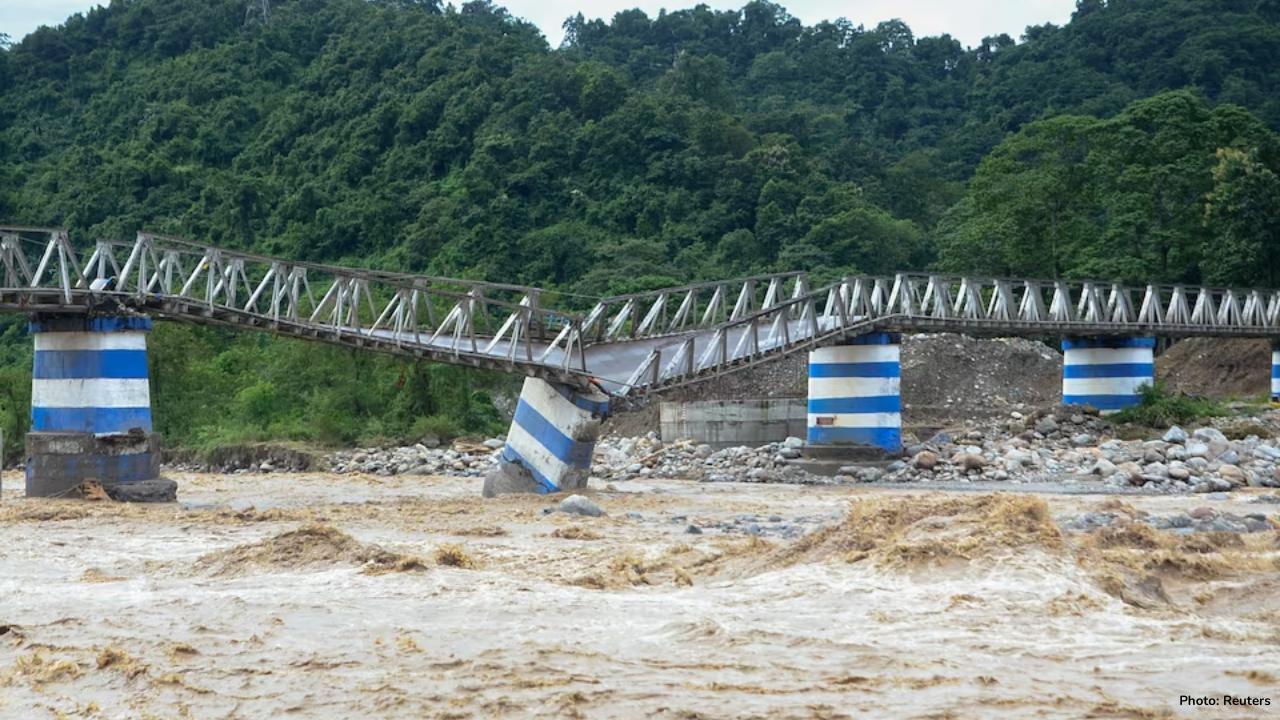
Post by : Monika
On October 5, 2025, the hilly region of Darjeeling in West Bengal, India, experienced extremely heavy rains that caused severe floods and landslides. According to reports, at least 18 people have lost their lives, and many others remain missing.
Homes, roads, and bridges were washed away, leaving communities isolated and rescue efforts extremely difficult. Authorities have warned that the death toll may rise as more information comes in from remote areas. The situation has caused panic among local residents and tourists, as the region is known for its scenic beauty, tea plantations, and popular tourist destinations.
The heavy rainfall has triggered a humanitarian crisis in Darjeeling and surrounding districts. Rescue and relief teams are working tirelessly to reach the stranded populations and provide immediate aid. However, the steep terrain, continuous rain, and destruction of key infrastructure are major obstacles to these efforts.
The Intensity of the Rainfall
The rainfall began late on the night of October 4 and continued into October 5. In just 24 hours, Darjeeling received a staggering 261 millimeters of rain, which meteorologists classify as “extremely heavy.” Nearby districts like Cooch Behar and Jalpaiguri received 192 and 172 millimeters of rainfall, respectively. Such intense rain led to rivers overflowing, mudslides, and landslides, which swept away houses and damaged essential infrastructure.
The Balason River, a major waterway in the region, overflowed due to the heavy rains. Two iron bridges over the river collapsed, severing critical connections between Siliguri, a major city in the plains, and Mirik, a hill town popular among tourists. The destruction of these bridges has left many communities cut off, making it difficult for rescue teams to reach affected areas quickly.
The Impact on Darjeeling and Surrounding Districts
Several districts in West Bengal were heavily affected, including Darjeeling, Kalimpong, Jalpaiguri, and Alipurduar. These areas are not only residential zones but also major centers for tea cultivation and tourism. In the town of Mirik, many homes have been washed away, and residents are stranded with limited access to food, clean water, and medical aid.
The landslides and floods have scattered debris across roads and highways, blocking travel and slowing rescue operations. The hilly terrain makes movement even more dangerous, and some areas remain completely inaccessible. Local authorities have called for extreme caution as more landslides may occur in the coming days due to continued rainfall.
Human Loss and Displacement
At least 18 people have died as a result of the floods and landslides. Many others are reported missing, and the number may rise as rescue teams reach remote villages.
Families have lost homes, livestock, and personal belongings, leaving them in a vulnerable situation. Temporary shelters have been set up, but the rising number of displaced individuals is straining the resources of the local administration.
The floods have affected not just residents but also tourists visiting the region. Darjeeling is famous for its natural beauty, tea gardens, and viewpoints such as Tiger Hill. Many tourists were stranded in hotels and guesthouses due to washed-out roads and collapsed bridges. Authorities have advised tourists to stay put until conditions improve and to follow official instructions for their safety.
Government Response and Relief Efforts
Mamata Banerjee, the Chief Minister of West Bengal, expressed deep concern over the situation. She stated that multiple roads have been washed away, bridges have collapsed, and large areas of land have been inundated. She also warned that the death toll could rise as more reports come in from inaccessible areas.
The state government has mobilized rescue and relief operations, involving the National Disaster Response Force (NDRF) and local authorities. These teams are working to clear debris, restore communication lines, and provide food, water, and medical aid to the affected populations.
Helicopters have been deployed to airlift stranded individuals from remote locations. However, the ongoing rainfall, landslides, and steep terrain make rescue operations extremely challenging.
Authorities have also coordinated with local hospitals to prepare for potential casualties and medical emergencies. Temporary medical camps have been set up in safe zones to provide first aid, treatment for injuries, and basic healthcare to displaced residents.
Infrastructure Damage
The floods and landslides have caused widespread damage to critical infrastructure. Roads and highways connecting hill towns to the plains have been washed away, while bridges over rivers like the Balason have collapsed. Communication lines have been disrupted, leaving many villages cut off from emergency services and news updates.
Electricity and water supply systems have also been affected. Power outages are widespread, and water pipelines have been damaged or contaminated by floodwaters. Repairing these systems will take time, adding to the hardships faced by residents in the affected areas.
The destruction of infrastructure also affects the local economy. Tea plantations, which are a major source of income for many families, have been damaged by landslides and floods. Tourist-related businesses, including hotels, restaurants, and transportation services, have suffered losses due to stranded tourists and unsafe travel conditions.
Warnings and Safety Measures
Authorities have issued warnings about the possibility of further landslides and floods. Residents living near rivers and steep slopes are advised to evacuate to safer areas. Tourists are advised not to travel in affected zones and to stay in secure accommodations until the situation stabilizes.
Local police and disaster management teams are working to guide people to temporary shelters. Evacuation centers are being equipped with basic necessities, including food, water, bedding, and medical supplies. Volunteers and community members are also assisting in rescue efforts, providing local knowledge to help navigate the difficult terrain.
Weather Forecast and Risks Ahead
Meteorologists have predicted that heavy rains may continue in Darjeeling and surrounding districts in the coming days. Continuous rainfall increases the risk of additional landslides, flooding, and road collapses. Authorities are closely monitoring the weather conditions and preparing for emergency measures if required.
Residents are urged to stay informed through official announcements and weather updates. Following safety instructions is crucial to prevent further casualties and to ensure that rescue operations can proceed efficiently.
Humanitarian Efforts and Community Support
Local communities have shown resilience and cooperation in responding to the crisis. Neighbors and local organizations have helped in evacuating vulnerable individuals, distributing food and water, and providing shelter to those affected. Volunteers are assisting government teams to reach remote areas and ensure that aid reaches those in need.
Non-governmental organizations (NGOs) and social groups have also stepped in to provide additional support, including medical aid, clothing, and psychological support for survivors traumatized by the disaster.
The floods have highlighted the importance of community solidarity and preparedness in responding to natural disasters, especially in hilly and vulnerable regions like Darjeeling.
Long-Term Implications
The floods and landslides in Darjeeling have not only caused immediate loss of life and property but also raised concerns about long-term recovery. Rebuilding homes, infrastructure, and public services will take time and significant resources.
There is also an economic impact to consider. The local economy relies heavily on tea production and tourism. Damage to plantations, roads, and hotels will affect livelihoods and may lead to financial difficulties for many families. Efforts to restore economic activity will be critical for the recovery of the region.
Authorities are likely to focus on strengthening disaster preparedness for the future. This may include better drainage systems, early warning mechanisms, and policies to prevent construction in high-risk areas prone to landslides and floods.
The heavy rains in Darjeeling, India, have caused devastating floods and landslides, resulting in at least 18 deaths and leaving many people missing. Homes, roads, and bridges have been washed away, isolating communities and making rescue efforts challenging. The government, rescue teams, and local communities are working tirelessly to provide relief and restore infrastructure.
Residents and tourists are advised to follow safety instructions, avoid traveling in affected areas, and rely on official updates. Continuous monitoring of weather conditions and coordinated relief efforts are essential to manage the ongoing crisis.
The disaster underscores the need for disaster preparedness, early warning systems, and strong community support to mitigate the impact of natural calamities in hilly regions. While the immediate focus is on rescue and relief, long-term planning and infrastructure improvement will be crucial to prevent similar tragedies in the future.










NBA Friday Recap: Powerhouse Wins for Miami, LA, Milwaukee, and Clippers
Miami, LA Lakers, Milwaukee, and Clippers triumphed in a thrilling NBA Friday, showcasing standout p

Doncic Shines with 49 Points in Lakers' 128-110 Victory over Timberwolves
Luka Doncic dazzles with 49 points as the Lakers secure a 128-110 win against the Timberwolves, show

Kings Triumph Over Jazz 105-104 with Last-Minute Sabonis Effort
The Sacramento Kings edged out the Utah Jazz 105-104, with Domantas Sabonis making the decisive shot

Argentina's Friendly Match Against India Delayed, New Date to be Announced
The friendly match between Argentina and India in Kochi has been postponed due to FIFA approval dela

Rohit and Kohli Conclude ODI Journeys in Australia with a Victory
Rohit Sharma and Virat Kohli bid adieu to Australian ODIs with a final win, forming a 168-run partne

George Russell's Wrestling Mask Antics at Mexican Grand Prix
George Russell donned a wrestling mask to enjoy the Mexican Grand Prix from the stands, providing a